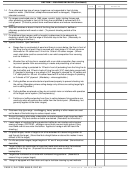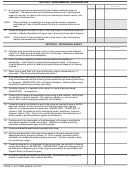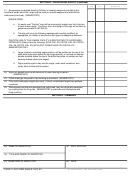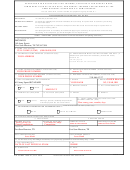Da Form 5687-R - Initial Inspection Checklist For Indoor Ranges Page 4
ADVERTISEMENT
SECTION II - ENVIRONMENTAL CONSIDERATIONS
YES
NO
REMARKS
27. An industrial hygienist has determined that the installed ventilation system is
acceptable. This determination shall be based on measurement of exhaust and
supply air volumes, air velocity at the firing line, downrange transport velocity, and
observation of turbulent flow.
NOTE:
When ventilation is inadequate, the range must be closed or exposure
controlled per Table of Lead Exposure Limits until corrective action can be
taken.
28. Personnel assigned or detailed to work in the firing range on a permanent basis are
enrolled in a Medical Surveillance Program and in a Hearing Conservation Program.
NOTE:
Personnel will not be permitted to work in firing range unless the foregoing
medical requirements are satisfied.
SECTION III - OPERATIONAL SURVEY
YES
NO
REMARKS
29. Plate/sand trap typo bullet stop has a layer of clean sand used to catch deflected
lead 6" to 8" deep running the width and in front of the stop. (Required to attenuate
bullets, prevent ricochet and backsplatter.)
30. Sand is screened regularly to remove lead and reduce the possibility of
backsplatter. Lead analysis is required before disposal of sand. (Frequency of
firing will determine amount of lead bullet-mass buildup and frequency of cleaning
required.)
31. When using a sand-filled "crib" type of bullet stop, slope is maintained at a 1:1
slope ratio. (This will provide best bullet attenuation.)
32. Door openings into the range (from the outside or adjacent rooms) in front of the
firing line are secured from the inside to prevent personnel from entering while firing
is in progress. (MANDATORY from a life safety standpoint. Where possible, doors
should be locked/secured and keys controlled.)
33. Ventilation system is in operation when range is in use and during cleanup.
(MANDATORY - no exceptions.)
34. Cleaning of the range is accomplished by vacuuming or wet methods. HEPA filters
are required on vacuum cleaners. (Dry cleaning methods, i.e., use of a hand
broom, with or without sweeping compound, are prohibited.)
35. Personnel assigned or detailed to work in the range are required to wear a NIOSH
approved respirator (for the removal of lead dust and fumes) while cleaning,
repairing, or reclaiming lead from bullet trap. (MANDATORY - TB MED 502, 15
February 1982, Occupational and Environmental Health, Respiratory Protection
Program, Table 2, Part 1, Dust, Fume, and Mist Respirators, lists respirators and
filters suitable to provide protection against lead exposure.)
36. Smoking and/or the consumption of food/beverages in the range is prohibited to
preclude the ingestion of lead into the body. (Should be included in prefiring
orientation and appropriate signs should be posted.)
37. Firers are advised to wash hands thoroughly after firing.
38. All personnel permitted in the range during weapons firing are required to wear
appropriate hearing protection devices, i.e., firers, coaches, spectators (where
permitted) and assigned/detailed operating personnel. (Failure to comply is basis
for removal from range.)
39. Personnel assigned to, or employed full-time at the range, are enrolled in a hearing
conservation program (TB MED 501). (MANDATORY - base level audiogram must
be made prior to beginning work in the range and periodically as prescribed by the
Support Activity Command Surgeon.)
40. All drapery has been removed from firing range. (Noise attentuation capability of
drapery is questionable, and it collects lead dust.)
PAGE 3, DA FORM 5688-R, DEC 90
DA FORM 5687-R. APR 88 IS OBSOLETE
ADVERTISEMENT
0 votes
Related Articles
Related forms
Related Categories
Parent category: Business
 1
1 2
2 3
3 4
4 5
5








